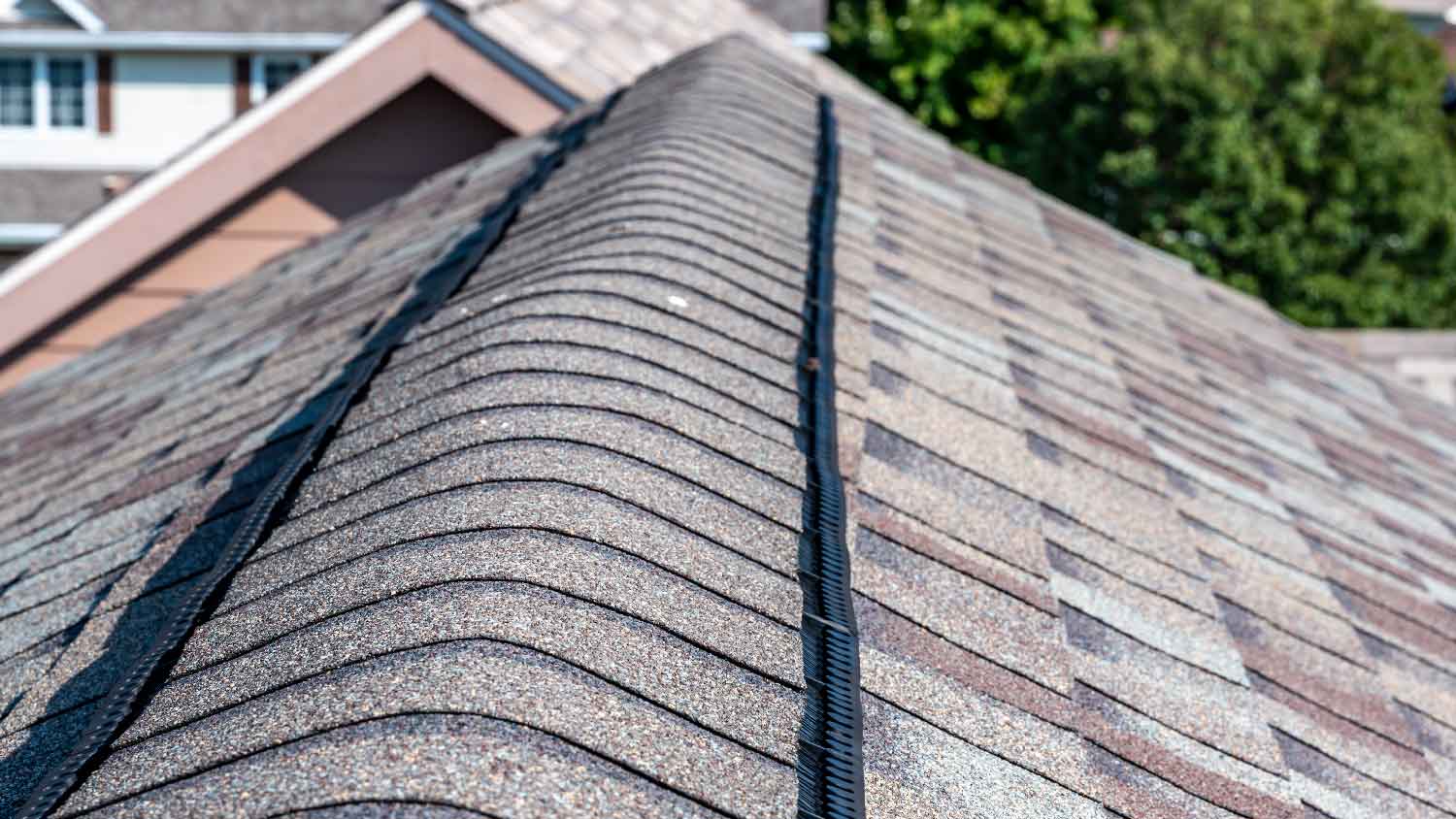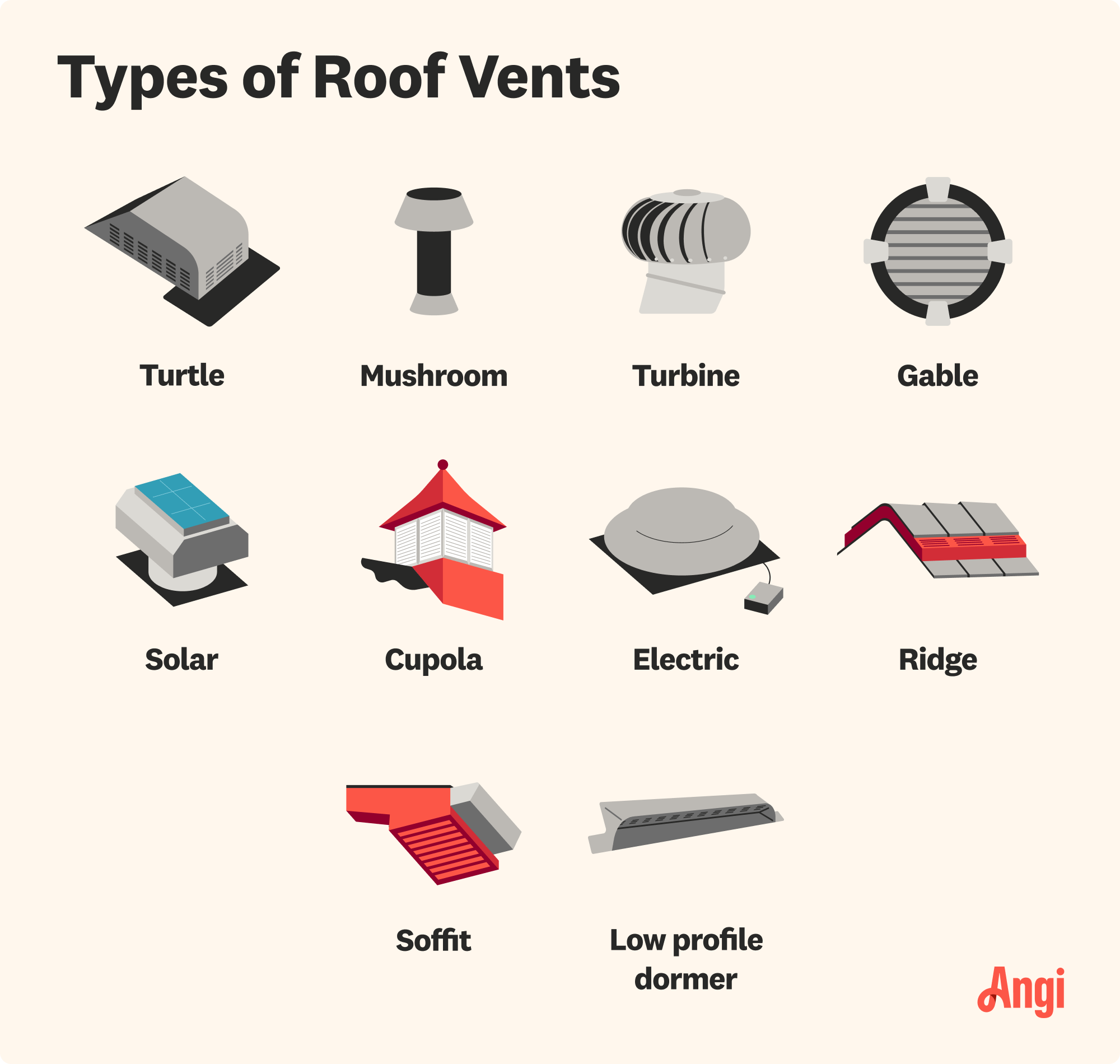What Is a Ridge Vent on a Roof and Do You Need One?
Improve the airflow in your attic without sacrificing curb appeal


Roof ridge vents are installed along the peak of the roof.
They improve airflow and extend a roof’s lifespan.
Ridge vents with baffles offer better protection against wind, rain, snow, and insects.
Ridge vents cost between $300 and $650 to install, on average.
When you’re searching for the best roof vent for your home to keep the air flowing in and the moisture out, you’ll likely come across ridge vents. In this guide, learn the benefits of ridge vents plus their cons and estimated costs.
What Is a Roof Ridge Vent?
Ridge vents are installed along the ridge, or peak, of the roof. Placed at the highest point of the roof, these vents help to control airflow in the attic by drawing warm air and moisture out, allowing air circulation.
Ridge vents are installed over an air slot that is cut directly into the roof deck and typically runs the entire length of the ridge. Once installed, it is covered with the roofing material which helps it blend into the roof.
Like your kitchen or bathroom, your roof needs ventilation to extend its life span and control temperatures. Proper roof ventilation helps reduce HVAC costs and prevents ice dams and moisture damage. A roof repair pro can assess your roof and make recommendations.
Types of Ridge Vents
There are two types of ridge vents: ones with a baffle and ones without a baffle, and the one you choose will depend on your particular roof and its needs. Most ridge vents in areas that get regular rain or snow use baffles.
A ridge vent with a baffle uses an external baffle to deflect rain, wind, snow, insects, and debris, keeping it from entering the vent and, ultimately, the attic.
Ridge vents without baffles reduce the suction that roof vents with baffles create. Air is allowed to flow into the ridge vent, which prevents warm air from escaping or only allows it to escape from one side of the vent.
Pros and Cons of Roof Ridge Vents
| Pros | Cons |
|---|---|
| Better attic airflow | Potential leakage |
| Good aesthetics | Tricky DIY install |
| Increased roof life | Won’t fit some roofs |
| Blocks insects | Snow penetration |
| Dissipates humidity | Costlier upfront |
If you have heat or humidity buildup in your attic, the biggest benefit of roof ridge vents is their ability to improve airflow in this space. If left unchecked, heat and humidity could cause mold and mildew in your attic, as well as an unpleasant, musty smell. As mold and mildew build up, your roof may suffer unnecessary rot damage, necessitating replacement.
The design of the roof ridge vents won’t detract from the look of your home or roof. They have a low profile that’s not obvious at a glance, unlike some other designs. Additionally, insects cannot penetrate these seamless-style vents.
However, the roof ridge vent design could allow snow or rain to penetrate, especially when high winds are driving the precipitation. Following the proper installation technique is key to reducing issues with this type of moisture penetration. Certain roof design styles, such as hip roofs, do not work well with roof ridge vents. Gable roof designs tend to accommodate this kind of vent well, though.
How Do Ridge Vents Compare to Other Types of Roof Vents?
What is a ridge vent and how does it compare to other venting options? Here is how these vents compare.
Soffit vent versus ridge vent: The soffit vent sits under the eaves of your home, while the ridge vent sits at the peak of the roof. Homeowners often use these two passive vents together for maximum airflow.
Gable vent versus ridge vent: The rectangular gable vent sits at the peak of the gable roof. It’s easier to install than the ridge vent, but the ridge vent is less likely to leak while providing greater airflow. Both types are passive vents.
Box vent versus ridge vent: Box vents can go anywhere along the slope of the roof. They are clearly visible, causing reduced curb appeal, unlike ridge vents. Ridge vents can move more air and have less of a chance of leaks than box vents. Both are passive vents.
Roof turbine versus ridge vent: Roof turbines use circular blades to catch wind. The turbine then spins and moves air inside the attic. Even though they don’t use electrical power, the moving parts mean roof turbines are not passive like ridge vents. Roof turbines cost less, but they tend to require more frequent maintenance than ridge vents. Some homeowners also consider them eyesores.

How Many Ridge Vents Does a Roof Need?
Unlike other styles of vents, where you count the number of vents you need, it’s easier to count ridge vents by the linear feet they occupy.
Each linear foot of a ridge vent provides about 18 square inches of passive venting capability. For passive vents, you should need 200 to 250 square inches of passive venting per 1,000 square feet of attic space.
Based on those numbers, here is approximately how many linear feet of roof ridge vents you need. If you have odd angles in the attic that significantly affect airflow, you’ll need more linear feet of ridge vents.
| Feet of Ridge Vents | Attic Space (Sq. Ft.) |
|---|---|
| 6–7 | 500 |
| 9–10 | 750 |
| 12–14 | 1,000 |
| 18–20 | 1,500 |
| 24–26 | 2,000 |
How Much Do Roof Ridge Vents Cost?

The average cost to install ridge vents is $300 to $650, including $2 to $3 per linear foot for the material and $45 to $75 per hour in labor fees. Here’s a look at how much it costs to have a pro who installs roof vents put in other kinds of vents:
Soffit vents: $315–$465
Gable vents: $60–$150
Roof turbine: $65–$250
However, most roofing contractors won’t charge extra to install ridge vents if you are replacing the entire roof. When choosing a roofer, find out if installing ridge vents will cost extra. If you need assistance with seeing whether the benefits of ridge vents are right for you, contact your local roofing contractor.
Signs You May Need to Install a Roof Ridge Vent
Roof ridge vent installation is best done when the entire roof is being replaced, but they can be added at any time. Here are some signs that your roof may need more ventilation:
Water damage or mold in the attic: High heat and humidity levels in the attic occur because of poor ventilation and airflow, leading to damage from excess moisture.
Ice dams in the winter: Without proper ventilation in the attic, you may have inconsistent temperatures on the surface of the roof. Melting snow from warmer areas can’t drain away because ice remains in place in colder areas and blocks the water flow. Ice dams eventually cause roof leaks.
Cracked or loose shingles: When temperatures are too hot in the attic, the excess heat can affect the integrity of the shingles overhead, causing them to break down or crack prematurely.
Extreme heat in the attic: If you feel a blast of hot air each time you enter your attic, this is a sign of poor ventilation, which can lead to a buildup of humidity and the formation of mold.
Unusually high energy bills: Proper ventilation in the attic improves the ability of your heating and cooling system to maintain consistent temperatures throughout the home, leading to lower energy costs.
Frequently Asked Questions
You can tell if you have ridge vents by looking at the roof’s peak from outside. A ridge vent will look like a speed bump or slight rise away from the roof’s surface and will likely be covered in the same material as the rest of the roof. You can also tell from inside your attic—look up at the roof ridge to see if there is light coming through along the length of the ridge.
Ridge vents can last as long as your roof does. As long as your ridge vents were installed correctly by a qualified professional, they will need very little upkeep. Inspecting your ridge vents annually to ensure they aren’t cracked, clogged, or leaking will help prolong their lifespan.
Rain shouldn’t come in through your ridge vents unless your vents are damaged or the rain is accompanied by very high winds. Most ridge vents use flashing or baffling to keep out rain, snow, and debris. If your ridge vent isn’t baffled, rain is more likely to enter your attic, so ridge vents with baffles are a better choice in areas with regular rainfall.





- Roofers
- Metal Roofing
- Roof Repair
- Roof Inspection
- Vinyl Siding Repair Contractors
- Flat Roofing Companies
- Commercial Roofing
- Emergency Roofing Companies
- Leaky Roof Repair
- Metal Roof Repair
- Business Roof Repair
- Flat Roof Repair
- Tile Roof Repair
- Slate Roofers
- Rubber Roofers
- Roofing & Siding
- Metal Roof Installation
- Affordable Roofing
- Roof Sealing
- Attic Ventilation Contractors
- Gable Vents vs. Ridge Vents: Pros, Cons, and Costs
- Ridge Vents vs. Turbines for Attic Ventilation
- How Soffit Vents Work to Keep Your Home Dry
- How Much Ventilation Does Your Attic Need?
- How to Build a Roof For Your Home, From Start to Finish
- What Is a Gable Vent and What Does It Do?
- How to Install Metal Roofing Like a Pro
- 30 Common Roofing Mistakes You Need to Know
- 6 Common Turbine Roof Vent Problems to Look Out For
- Explore the Pros and Cons of Roof Cleaning












